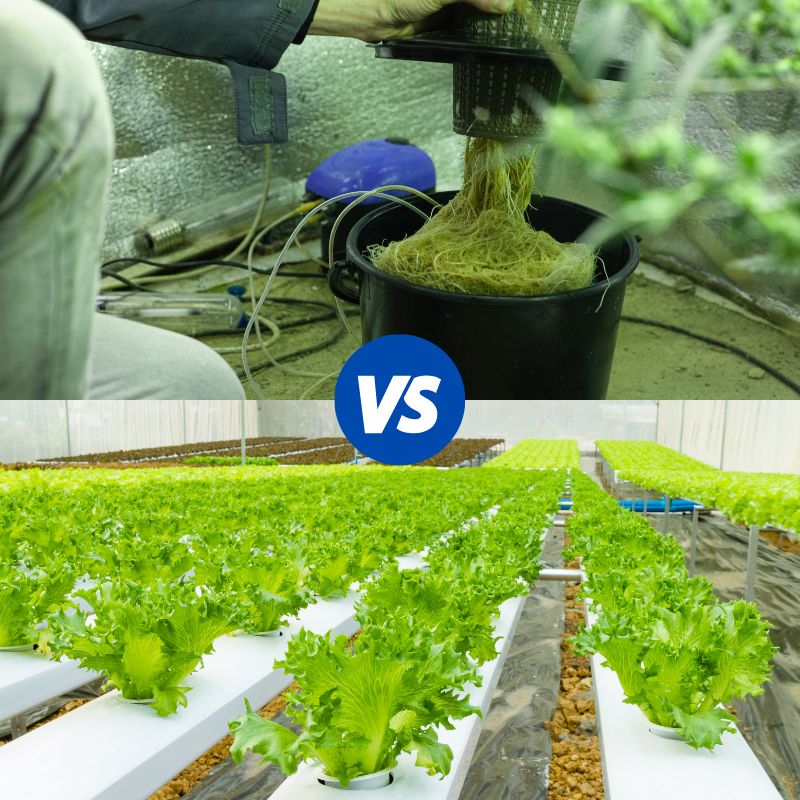
Setting up your hydroponic grow system is exciting, although with different types of grow systems and supplies can be confusing to know which is best for you. No matter what type of hydroponic growing system you choose, there are basically only two options when it comes to choosing an irrigation method, you will either recirculate your water, or drain to waste.
What’s the Difference Between Drain-to-Waste and Recirculating?
Knowing the difference between drain to waste and recirculating, and the pros and cons of each watering method, will help you choose the method that works best for you. One grower’s drawback may be another grower’s benefit, depending on unique circumstances.
Drain to Waste
A drain to waste system is just what it sounds like, your plants are sprayed or watered with fresh water and nutrients with the runoff water being expelled and drained to waste. The runoff water may be around 15% to 20% by volume that is entirely discarded. Something like an aeroponic system which mists beautiful bunches of roots with fresh water and nutrients would be a drain to waste system.
Recirculating
A recirculating system is also pretty self-explanatory, the water is recirculated by returning to a reservoir to be used again and to continue feeding the plants. This is the case with an Ebb and Flow hydroponic grow system, or a Deep Water Culture method that often uses an air stone to keep oxygen in the water and help prevent disease.
There are pros and cons to each method, learning the differences can help you to make an informed decision to choose the method that best suits your growing environment.
Drain to Waste: Pros and Cons
Pros of Drain to Waste
- Allows for using many types of grow media
- Waterborne diseases are less likely
- Lower possibility of clogging emitters
- Straightforward flushing of salt accumulation
- Plants are fed fresh nutrient solution with the same pH and EC every irrigation cycle
- Some pest control products can be easily applied in drenches
Cons of Drain to Waste
- Applicable to limited types of hydroponic systems
- Increased water usage requirements
- Increased nutrient usage can add to costs
- Pesticide and fertilizer leaching may happen more often
- Salt accumulation can occur several times
Recirculating: Pros and Cons
Pros of Recirculating
- Water and nutrient solution is recycled
- Water usage is reduced
- Fewer nutrients are required throughout the production cycle
- Leaching of nutrient solution and fertilizer is minimized
- Various types of hydroponic grow systems can be recirculating
Cons of Recirculating
- PH and EC nutrient solution can fluctuate
- Ratios of all nutrients can fluctuate
- Increased risk of waterborne diseases
- More labor intensive salt flushing
- Biofilms and algae more prone to clogging emitters without appropriate action
Plants take in nutrients from the first introduction to clean, fresh water and they also excrete organic matter and minerals, which can contaminate some recirculating systems if you’re not careful. Recirculating systems do provide some time and cost savings although if something goes wrong in a recirculating system it can go wrong very quickly. Drain to waste is much more forgiving in this regard.
RainMakers Supply For All Your Hydroponic Grow Systems
The horticulture and hydroponic grow specialists at RainMakers Supply can help you to evaluate the best systems for you and your grow environment. We offer a wide selection of high quality hydroponic growing supplies and equipment combined with exceptional customer service.
RainMakers Supply offers quality hydroponic growing supplies, equipment and tips from experienced growers. Choose from the best brand names and suppliers of grow media, soils, lighting, nutrients, pumps, grow tents, and more. Contact us to learn more about setting up your hydroponic grow system and help with choosing either recirculating or drain to waste watering methods.
